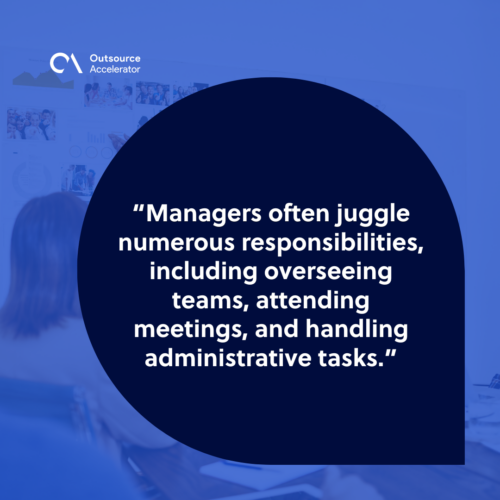Maker vs. Manager: A side-by-side comparison

Productivity and time management have become paramount in modern work environments due to the rapid advancement of technology that has led to an increase in the pace of work today.
With tools and platforms facilitating instant communication and information access, expectations for quick turnaround times have risen exponentially. As a result, individuals must effectively manage their time to keep up with the demands of a fast-paced work environment.
Moreover, the rise of remote work and flexible work arrangements has blurred the boundaries between professional and personal life. While offering newfound flexibility, this shift has also introduced challenges in managing time effectively amidst various distractions.
Within this landscape, two distinct personas emerge: the “maker” and the “manager.”
This article explores the delicate balance between maker vs. manager, shedding light on how individuals can navigate and excel in both.
What is the maker’s schedule?
Unlike managers, who often operate in fragmented intervals, makers require extended periods to enter a state of flow and achieve optimal productivity.
The maker’s schedule is characterized by long, uninterrupted blocks of time dedicated to deep work and creative pursuits.
Makers thrive on sustained periods of concentration, allowing them to delve deeply into complex tasks and produce high-quality output.

Maker’s schedule tips to remember
Here are some valuable tips to help you harness the power of concentrated work time and maximize your creative potential:
Guard your time jealously
Protecting uninterrupted blocks of time is crucial for maintaining focus and productivity as a maker. Establish clear boundaries and communicate them to colleagues, ensuring that you have the space and freedom to immerse yourself fully in your work.
Minimize interruptions
Distractions can disrupt your creative flow and derail your progress. Take proactive steps to minimize interruptions, whether it’s silencing notifications, finding a quiet workspace, or setting specific work hours when you’re least likely to be disturbed.
Batch communication tasks
Grouping similar tasks can streamline your workflow and enhance efficiency.
Whether it’s responding to emails, conducting research, or brainstorming ideas, batching tasks allows you to stay focused and avoid context switching.
For instance, imagine you’re a graphic designer working on a new project for a client. Instead of switching between different design tasks throughout the day, you should batch similar tasks together.
In the morning, you dedicate a block of time to brainstorming ideas and sketching rough concepts for the project. During this focused session, you immerse yourself fully in the creative process without distractions.
Schedule meetings wisely
While meetings are necessary for collaborative work environments, they can also disrupt a maker’s schedule if they are not managed efficiently.
Prioritize scheduling meetings during times when they are least likely to disrupt concentrated work periods, such as at the beginning or end of the day.
What’s the manager’s schedule?
In contrast to the maker’s schedule, managers often juggle numerous responsibilities, including overseeing teams, attending meetings, and handling administrative tasks.
As a result, their schedules are frequently halted by frequent interruptions and shifting priorities. This makes it challenging to maintain a consistent focus on any single task for an extended period.

Manager’s schedule tips to remember
Here are some essential tips to keep in mind when operating within a manager’s schedule:
Prioritize time blocking
Dividing your day into manageable blocks of time is akin to creating a roadmap for your productivity journey.
By segmenting your schedule into distinct periods dedicated to specific tasks and responsibilities, you establish a framework that fosters efficiency, focus, and goal attainment.
Maintain availability for the team
As a manager, your accessibility is vital for supporting your team members. Make yourself available for questions, guidance, and feedback with a scheduled date and time so that talking to your team will not affect your other responsibilities.
Practice effective delegation
Delegation is a cornerstone of effective management. By entrusting tasks to capable team members, managers can free up time to focus on high-priority initiatives and strategic objectives.
Additionally, unlike makers, who often prefer to maintain control over every aspect of their work, managers recognize the value of distributing tasks among their team members.
This distinction between maker vs. manager highlights the importance of leveraging delegation as a strategic tool for optimizing productivity and driving organizational success.
Embrace flexibility and adaptability
The managerial role is inherently dynamic, requiring individuals to navigate unforeseen challenges and shifting priorities.
Cultivating a mindset of flexibility and adaptability enables managers to respond agilely to changing circumstances and seize opportunities as they arise.
Balancing the maker’s schedule and manager’s schedule
The maker vs. manager dichotomy underscores the diverse skill sets and roles present within organizations.
However, rather than viewing them as mutually exclusive, organizations should embrace each other’s unique strengths and foster an environment that encourages effective time management.
Achieving a harmonious balance between the maker’s schedule and the manager’s schedule requires planning and prioritization.
Maker vs. Manager: Is one better than the other?
Which scheduling has a manageable process, maker or manager?
Actually, both schedules serve distinct purposes and play integral roles in driving productivity and achieving organizational goals.
For individuals who thrive on deep, focused work and creative exploration, the maker’s schedule provides an ideal framework for maximizing productivity and producing high-quality output.

Conversely, those who excel in managing teams, coordinating activities, and driving strategic initiatives may find the manager’s schedule better suited to their strengths and responsibilities.
Flexibility, adaptability, and a willingness to experiment with different approaches are key to finding a balance that optimizes productivity and satisfaction between the two roles.







 Independent
Independent




